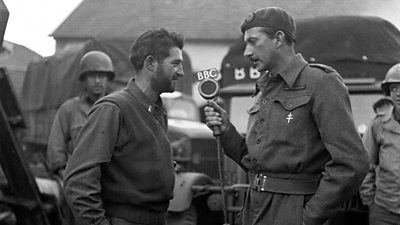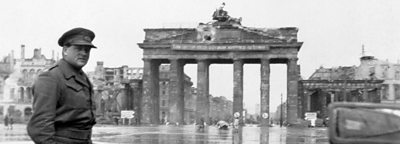Richard Dimbleby, ±«Óãtv War Correspondent, at the Brandenburg Gate, Berlin in July 1945.
D-day has come
Operation Overlord, the long-awaited allied assault on occupied Europe, was under way hours before the Germans, and indeed listeners at home, got wind of it. Ships set sail, planes and gliders took off from airfields, and the south coast was a hive of activity on the night of 5 June 1944 .
After a brief announcement from newsreader John Snagge in the studio, a recording of the voice of General Eisenhower from his Supreme Command HQ in London followed, declaring that D-Day had come.
Soon the first accounts were coming in. Correspondent Howard Marshall described what happened when his barge hit a mine. "I'm sitting in my soaked-through clothes with no notes at all. all my notes are sodden. they are at the bottom of the sea".
Reporters described the battles on the beach, the swift advances into the French countryside, and the successes and setbacks along the way. In places the resistance fell away, and the enemy surrendered in numbers. But the Germans fought doggedly to hold the Cherbourg peninsular, to recapture Caen, and to escape the allied trap at Falaise.
At home and abroad, huge audiences would wait with bated breath for War Report from the ±«Óãtv, and for what was to become a famous link: "And now, over to Normandy."
It was a triumphant campaign, but not all the news was good. There were setbacks, which were reflected in the reports. Gillard described the "sickening sight" of the devastation suffered by Caen, which was a smoking ruin after three days of bombardment.
In June 1944, the ±«Óãtv occupied the tower of the chateau at Creully near Bayeux as its base for broadcasting reports of the D-Day landings back to the UK. For several weeks, correspondents recorded their reports in a small makeshift studio which became one of the busiest and most important broadcast centres in the world during that time. The studio still exists today, and the ±«Óãtv returned years later to commemorate the space, which is now a museum.
In the bitter winter of 1939 good recordings made on disc were difficult to preserve. Often ±«Óãtv engineers would take the acetate discs to bed with them to ensure they didn't develop frost patterns which would ruin the surface and render them unusable.
Back at Broadcasting House, the newsroom could barely cope with the sheer volume of incoming news. Such was the pressure that the Roneo copying machine - state of the art technology in those days - would frequently break down and have junior staff in tears.
There were many casualties on both sides in the Allied advance - including two ±«Óãtv correspondents. Kent Stevenson died while reporting on a raid over northwest Germany two weeks after D-Day, and Guy Byam was killed in a US Air Force raid over Berlin on 3 February 1945.
Soon the first accounts were coming in. Correspondent Howard Marshall described what happened when his barge hit a mine. "I'm sitting in my soaked-through clothes with no notes at all. all my notes are sodden. they are at the bottom of the sea".
Reporters described the battles on the beach, the swift advances into the French countryside, and the successes and setbacks along the way. In places the resistance fell away, and the enemy surrendered in numbers. But the Germans fought doggedly to hold the Cherbourg peninsular, to recapture Caen, and to escape the allied trap at Falaise.
At home and abroad, huge audiences would wait with bated breath for War Report from the ±«Óãtv, and for what was to become a famous link: "And now, over to Normandy."
It was a triumphant campaign, but not all the news was good. There were setbacks, which were reflected in the reports. Gillard described the "sickening sight" of the devastation suffered by Caen, which was a smoking ruin after three days of bombardment.
In June 1944, the ±«Óãtv occupied the tower of the chateau at Creully near Bayeux as its base for broadcasting reports of the D-Day landings back to the UK. For several weeks, correspondents recorded their reports in a small makeshift studio which became one of the busiest and most important broadcast centres in the world during that time. The studio still exists today, and the ±«Óãtv returned years later to commemorate the space, which is now a museum.
In the bitter winter of 1939 good recordings made on disc were difficult to preserve. Often ±«Óãtv engineers would take the acetate discs to bed with them to ensure they didn't develop frost patterns which would ruin the surface and render them unusable.
Back at Broadcasting House, the newsroom could barely cope with the sheer volume of incoming news. Such was the pressure that the Roneo copying machine - state of the art technology in those days - would frequently break down and have junior staff in tears.
There were many casualties on both sides in the Allied advance - including two ±«Óãtv correspondents. Kent Stevenson died while reporting on a raid over northwest Germany two weeks after D-Day, and Guy Byam was killed in a US Air Force raid over Berlin on 3 February 1945.
It was a triumphant campaign, but not all the news was good. There were setbacks, which were reflected in the reports. Gillard described the "sickening sight" of the devastation suffered by Caen, which was a smoking ruin after three days of bombardment.
In June 1944, the ±«Óãtv occupied the tower of the chateau at Creully near Bayeux as its base for broadcasting reports of the D-Day landings back to the UK. For several weeks, correspondents recorded their reports in a small makeshift studio which became one of the busiest and most important broadcast centres in the world during that time. The studio still exists today, and the ±«Óãtv returned years later to commemorate the space, which is now a museum.
In the bitter winter of 1939 good recordings made on disc were difficult to preserve. Often ±«Óãtv engineers would take the acetate discs to bed with them to ensure they didn't develop frost patterns which would ruin the surface and render them unusable.
Back at Broadcasting House, the newsroom could barely cope with the sheer volume of incoming news. Such was the pressure that the Roneo copying machine - state of the art technology in those days - would frequently break down and have junior staff in tears.
There were many casualties on both sides in the Allied advance - including two ±«Óãtv correspondents. Kent Stevenson died while reporting on a raid over northwest Germany two weeks after D-Day, and Guy Byam was killed in a US Air Force raid over Berlin on 3 February 1945.
In the bitter winter of 1939 good recordings made on disc were difficult to preserve. Often ±«Óãtv engineers would take the acetate discs to bed with them to ensure they didn't develop frost patterns which would ruin the surface and render them unusable.
Back at Broadcasting House, the newsroom could barely cope with the sheer volume of incoming news. Such was the pressure that the Roneo copying machine - state of the art technology in those days - would frequently break down and have junior staff in tears.
There were many casualties on both sides in the Allied advance - including two ±«Óãtv correspondents. Kent Stevenson died while reporting on a raid over northwest Germany two weeks after D-Day, and Guy Byam was killed in a US Air Force raid over Berlin on 3 February 1945.
War Report
War Report was the forerunner of the modern News Special, and a landmark in broadcast journalism. It was to enhance the ±«Óãtv's reputation and provide an unprecedented platform for the foreign correspondents.
The launch of War Report coincided with the launch of the Allies' D-Day invasion, and with the launch of a new kind of reporting, using eye-witness techniques, soundbites and personal accounts, illustrated with sounds and "radio pictures" from the action.
It also saw the introduction of a new kind of correspondent - trained in gunnery, signals, reconnaissance, aeroplane and tank recognition, and map-reading. They went on assault courses and battle courses before the campaign, and were attached to regular army units so they could be close to the action. And they had a new piece of equipment - the Midget Recorder. Developed by ±«Óãtv engineers, it enabled reporters to capture for the first time the sounds of battle and the words of men in action.
For 11 months the ±«Óãtv correspondents were in the vanguard, covering the desperate exchanges on the D-Day beaches, the battle for Caen, the advance through Normandy, the liberation of Paris in August 1944, the debacle at Arnhem the following month, and finally the German surrender in May 1945.
In all, some 235 War Reports, comprising more than 1,500 despatches, were broadcast by the ±«Óãtv.

